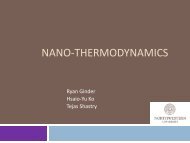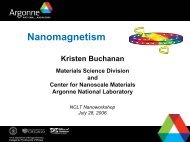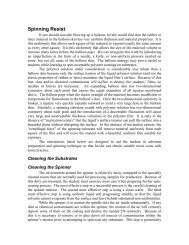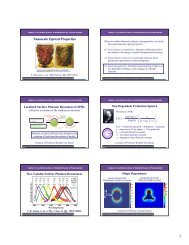A Practical Guide to SPM
A Practical Guide to SPM
A Practical Guide to SPM
Create successful ePaper yourself
Turn your PDF publications into a flip-book with our unique Google optimized e-Paper software.
7<br />
The scanning tunneling microscope (STM) is the ances<strong>to</strong>r of all<br />
scanning probe microscopes. Invented in 1981 at IBM Zurich, it was<br />
the first instrument <strong>to</strong> generate real-space images of surfaces with<br />
a<strong>to</strong>mic resolution. The inven<strong>to</strong>rs, Gerd Binnig and Heinrich Rohrer,<br />
were awarded the Nobel Prize in Physics five years later for<br />
this invention.<br />
The probe in an STM is a conducting sharp tip (typically made of<br />
platinum-iridium or tungsten). A bias voltage is applied between the<br />
tip and the sample. When the tip is brought close enough <strong>to</strong> the<br />
sample, electrons begin <strong>to</strong> “tunnel” through the gap, from the tip in<strong>to</strong><br />
the sample, or vice versa, depending on the polarity of the bias<br />
voltage. The resulting tunneling current varies with tip-sample distance<br />
and is the detec<strong>to</strong>r signal used <strong>to</strong> create an STM image. Note that for<br />
tunneling <strong>to</strong> take place, both the sample and the tip must be<br />
conduc<strong>to</strong>rs or semiconduc<strong>to</strong>rs. Unlike AFMs, which are discussed in<br />
the next section, STMs cannot image insulating materials.<br />
The tunneling current is an exponential function of the distance such<br />
that in a typical experiment if the separation between the tip and the<br />
sample changes by about an Ångstrom, the tunneling current changes<br />
by an order of magnitude. This gives the STM its remarkable<br />
sensitivity. The STM can image the surface of a sample with a<strong>to</strong>mic<br />
resolution — vertically and laterally.<br />
Mirror<br />
Cantilever<br />
Laser diode<br />
PSPD detec<strong>to</strong>r<br />
Sample<br />
PZT scanner<br />
A<strong>to</strong>mic Force Microscopy (AFM)<br />
The a<strong>to</strong>mic force microscope (AFM) grew out of the STM and <strong>to</strong>day<br />
it is by far the more prevalent of the two. Unlike STMs, AFMs can be<br />
used <strong>to</strong> study insula<strong>to</strong>rs, as well as semiconduc<strong>to</strong>rs and conduc<strong>to</strong>rs.<br />
The probe used in an AFM is a sharp tip, typically less than 5µm tall<br />
and often less than 10nm in diameter at the apex. The tip is located<br />
at the free end of a cantilever that is usually 100–500µm long. Forces<br />
between the tip and the sample surface cause the cantilever <strong>to</strong> bend,<br />
or deflect. A detec<strong>to</strong>r measures the cantilever deflections as the tip is<br />
scanned over the sample, or the sample is scanned under the tip. The<br />
measured cantilever deflections allow a computer <strong>to</strong> generate a map<br />
of surface <strong>to</strong>pography. Several forces typically contribute <strong>to</strong> the<br />
deflection of an AFM cantilever. To a large extent, the distance regime<br />
(i.e., the tip-sample spacing) determines the type of force that will<br />
be sensed.<br />
Figure 2-3. Typical optical detection scheme in AFM.<br />
Variations on this basic scheme are used <strong>to</strong> measure <strong>to</strong>pography as<br />
well as other surface features. There are numerous AFM modes. Each<br />
is defined primarily in terms of the type of force being measured and<br />
how it is measured.
















